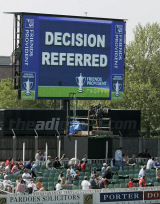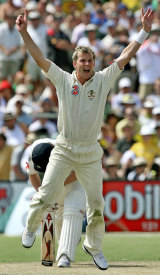Replays not an instant success
The umpire's decision is final. But now that philosophy is being put to the test in county cricket with the use of TV referrals for any decision
Andrew McGlashan
10-May-2007
|
|

|
"You're messing with my career, Darrell"
Mark Ramprakash to Darrell Hair after being given out lbw against South Africa at Lord's in 1998.
Mark Ramprakash to Darrell Hair after being given out lbw against South Africa at Lord's in 1998.
The umpire's decision is final. It's what cricketers are taught from their early days. But now that philosophy is being put to the test in county cricket with the use of TV referrals for any decision.
The ECB has opted to try out the new system during the Friends Provident Trophy, and there have now been three games where captains or batsmen have been able to ask the third umpire to take a second look at an on-field decision of their colleague. To date, there hasn't been a single decision overturned. The guideline is that "a clear and obvious mistake" must have been made for an overrule and, so far, the referrals have not given the third umpire sufficient grounds to change the verdict.
Following the lead of tennis, which offers two challenges to line calls per set, each side is allowed two referrals per innings. If the referral is unsuccessful, they lose it. Chris Adams, the Sussex captain, was the first batsman involved when he was struck on the pad by Somerset's Peter Trego and given out. Adams challenged the decision - but admitted he felt uncomfortable doing so - and the third umpire Barry Leadbeater saw nothing that warranted an overrule. Later in the same game, Mushtaq Ahmed unsuccessfully queried a not-out decision for an lbw, and replays of Craig Kieswetter's caught behind proved inconclusive.
What the early days of the trial have shown is that without the aid of added technology, such as Hawk-Eye and Snickometer, the pictures rarely prove enough to outweigh the benefit-of-the-doubt philosophy. Therefore, the human interpretation, and potential for error, is purely being sent from the field to the third umpire. The ECB has said it may introduce Hawk-Eye for the semi-finals and final, but it can't be uniformly used at a televised match. There are large costs involved, sizeable manpower needed, limited Hawkeye equipment to go round, and some grounds are not set up to take the incredibly sensitive equipment.
It is being brought into Wimbledon this year, but only on the two main courts because of these restraints and the logistics for taking it around the county circuit would be even greater. So even if Sky had cameras at more matches, it wouldn't mean the referrals system would be done in a better way.
Another issue is that each referral has to be made instantly (to prevent signals from the dressing room). Even the advanced technology, such as Snickometer, which would give the third umpire more evidence to work with, takes time to create the pictures that are flashed up on TV screens and this would slow the game down even more. It is certainly a made-for-TV development - they revel in a bit of suspense - and those at the ground have been left rather in the dark. The replays that the third umpire watches are not shown on the big screens and supporters are sometimes unsure about what they are waiting for and why a decision has been referred.
The other aspect is where to draw the line between a correct and incorrect decision. In Monday's televised match between Durham and Lancashire, Mal Loye was rapped on the pads by Steve Harmison, whose appeal was turned down before the Durham captain challenged it. Neil Mallender's not out decision stayed - the ball appeared to be heading over the stumps - but what if Mallender had said out and Loye had referred it. Would the third umpire have reversed the decision? Probably not. So is this an exercise in futility?
Even introducing Hawk-Eye wouldn't solve all the uncertainty. While it has purely been used as a TV aid commentators have made it clear that a ball clipping the outside of leg stump and given not out is a fair decision because of the doubt involved. However, if it becomes available to the third umpire as a decision-making tool then what are the parameters for ruling out or not out? There could be some drastically lower batting averages and much shorter matches, which wouldn't please the TV companies and advertisers.
|
|

|
It's unfair to jump to conclusions about the system so early in the trial. The ECB needs to be applauded for at least giving it a try. Only six county captains have had a chance to experience the regulations and there's a chance some won't even get the opportunity in this year's competition. That's a very small sample, but after the rushed introduction of Supersubs - brought into international cricket before being tested anywhere - it's certainly better than nothing.
It isn't the first time referrals have been tried. They were actually part of international cricket for a brief period during the 2002 Champions Trophy in Sri Lanka, although only for lbws and whether a catch carried. But during that experiment it was the umpire who asked for the TV replay, as he would with run-outs or stumpings. Shoaib Malik was the first batsman to be given out via a referral and Wisden reported: "The experiment largely worked for lbws, but the camera continued to be hopelessly ineffectual at confirming whether a catch had carried."
The ECB are due to send a report to ICC between the end of the group stage and the semi-finals. Their findings will be watched read with interest, but it's going to take a lot more convincing that technology is the answer to everything.
Andrew McGlashan is a staff writer on Cricinfo